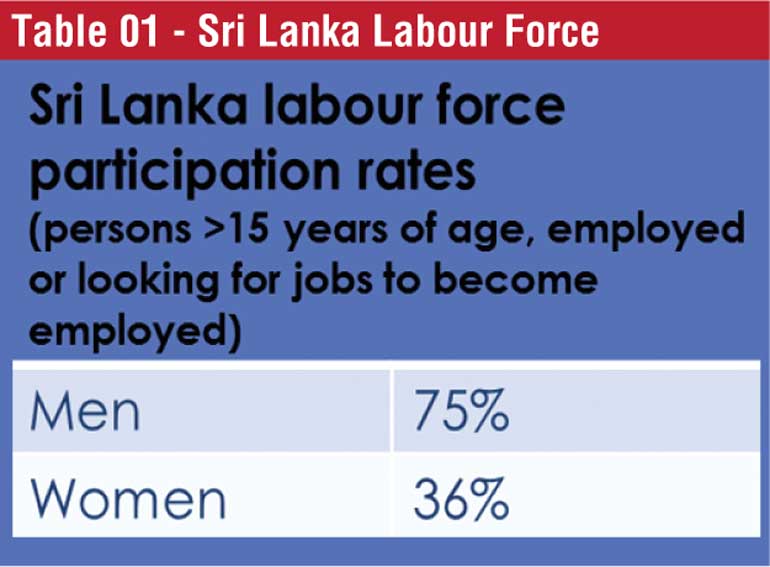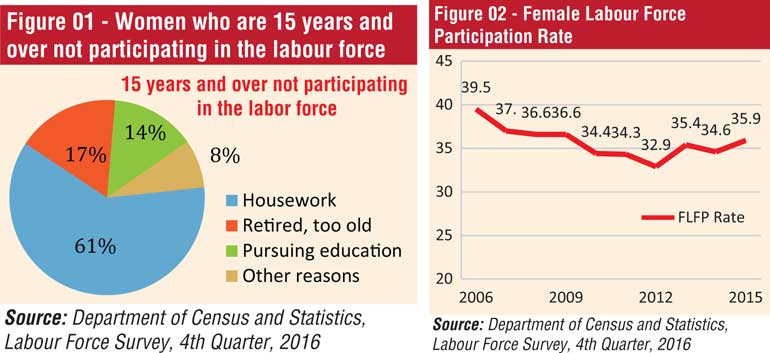Thursday Dec 12, 2024
Thursday Dec 12, 2024
Monday, 25 September 2017 00:00 - - {{hitsCtrl.values.hits}}

 The current female labour force participation rate is 36%, according to the 2016 fourth quarter of Sri Lanka Labour Force Survey published by the Department of Census and Statistics in Sri Lanka.
The current female labour force participation rate is 36%, according to the 2016 fourth quarter of Sri Lanka Labour Force Survey published by the Department of Census and Statistics in Sri Lanka.
At present, there are 5,313,997 women who are not in the labour force. The reasons for their lack of motivation to join the labour force have been identified by many studies and policy papers (Gunatilaka 2013, Gunewardena 2015, ILO 2016, Gunatilaka et al. 2017). The challenge is to motivate at least 5% of this number to enter the workforce with a view of creating economic wealth through paid work.
There is ample evidence worldwide that when women engage in paid employment, it makes their families, communities and countries wealthier.1 Some estimates have put the global loss to GDP from women’s non-participation in the economy at the size of the US and Chinese economies (McKinsey Global Institute, 2015).
Evidence points several constraints for women’s participation in the labour force – ranging from archaic legislation to the lack of access to vocational training – it has become increasingly evident that social and cultural factors play a defining role in determining women’s inclusion in the labour market.
A Committee under the aegis of the National Human Resources Development Council (NHRDC), identified five areas in which interventions are needed to meet this objective. The Committee was headed by Chiranthi Cooray, Chief HR Officer, Hatton National Bank and included the following:
Prof. Dileni Gunawardena, Senior Lecturer, University of Peradeniya; Dr. Nisha Arunathilaka, Research Fellow, Institute of Policy Studies; Dr. Ramani Gunatilaka, Independent Consultant, former Economist at Institute of Policy Studies; S.M. Gotabaya Jayarathne, former Secretary, Ministry of Labour and Trade Unions Relations; Sunil Abeywardena, State Secretary, Ministry of Labour and Trade Unions Relations; J.P.S. Jayasinghe, Director Planning, Ministry of Women and Child Affairs; Padmini Ratnayake, Advisor to the Minister, Ministry of Foreign Employment; Prof. Preethi Udugama, Senior Lecturer, University of Colombo; Dr. B.W.R. Damayanthi, Senior Lecturer, University of Sri Jayawardenapura; H.G.G.J Dharmasena, Director General, Department of Manpower and Employment; A. Wimalaweera, Senior Assistant Secretary, Ministry of Labour and Trade Unions Relations; P. Mahadevah, Commissioner of Labour, Department of Labour; Murtaza Esufally, Group Director, Hemas Group; Arjuna Herath, Senior Partner, Ernst & Young; Gayani de Alwis, Chairperson, Women in Logistics and Transport; Alikie Perera, Deputy Secretary General, Ceylon Chamber of Commerce; Aroshi Nanayakkara, CEO, Global Consulting Company; Ayomi Fernando, Assistant DG, Employers’ Federation of Ceylon; Shiromal Cooray, Managing Director, Jetwing Travel/Chairperson, SLID; Dr. Ruanthi De Silva, Founder/CEO, SCM PLUS Ltd.; Eranthi Premaratne, General Manager, MAS; Upulka Munasinha, Head of HR, Hemas; Cathrine Weerakkody, Investment Analyst, AIA Insurance; Prof. Rangika Halwatura, Senior Lecturer, University of Moratuwa.
According to the NHRDC, studies suggest that educated women in Sri Lanka prefer to join the state sector or not join the workforce at all. Nevertheless, the private sector employs the highest number of female employees. In 2015, there were 977,271 female employees in the private sector, which is 35.8% of the total employed population of the country (Sri Lanka Labour Force Survey – 2015).
Among the reasons that state sector employment appeals to educated women in Sri Lanka are enhanced maternity benefits, short working hours and pension benefits. Among reasons why educated women do not enter the workplace at all, are safety concerns, security, transportation, child and elder care responsibilities, gender-based pay inequities and lack of employable skills (Gunatilaka, 2013).
A study based on the World Bank’s Skills Toward Employment and Productivity (STEP) method, establishes that there is hardly a gender-based skill gap in terms of cognitive skills (Gunewardena, 2015), contrary to popular thinking.
The study indicates that married women with young children are less likely to be in paid employment, and points to the lack of social and systemic recognition of dual income earning families in our culture, and the resultant disincentives to join the labour force.
The Committee recommends that the government sets itself the goal of increasing the Female Labour Force participation (FLFP) rate to reach 40% by 2020. This is a challenging task, considering the FLFP in this country has been stagnant at mid-30% for the last two decades and has declined from 39.5% in 2006 to 35.9% by 2015.
The task force identified five key areas in which interventions are needed to meet this objective:
The interventions outlined in the report recommends that the government, the private sector, multi-lateral agencies and the community join hands and partner to achieve the set goals at a national level and thereon at sector and industry levels.
The success of the above outlined initiatives and action plans according to the report requires the leadership and competent personnel who appreciates that women’s economic participation or womenomics is an integral part for Sri Lanka›s current and future economic success.
The Committee also highlighted the need for positive media messages that reach women on a deeper level. The report was presented to Prime Minister Ranil Wickremesinghe by the National Human Resource Council of Sri Lanka.
Footnotes
1 In the words of a DFID tweet #EmpowerWomen, September 2015